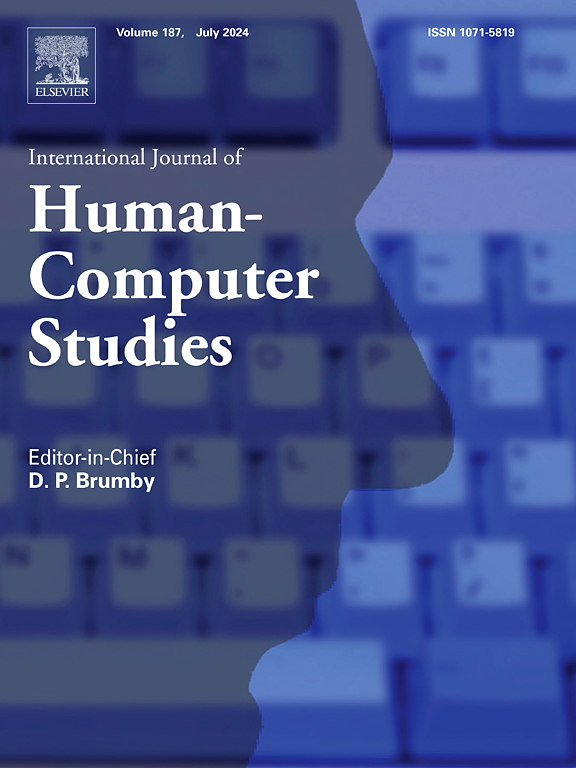Understanding workers’ psychological states and physiological responses during human–robot collaboration
IF 5.3
2区 计算机科学
Q1 COMPUTER SCIENCE, CYBERNETICS
International Journal of Human-Computer Studies
Pub Date : 2025-04-12
DOI:10.1016/j.ijhcs.2025.103516
引用次数: 0
Abstract
The integration of collaborative robots (cobots) in manufacturing industries has triggered special attention toward human operators and their cognitive, affective, and behavioral responses to the collaboration with these robots. In this framework, the number of metrics and the interrelated nature of the cognitive phenomena they may reflect (e.g., workload, stress, fatigue, affective state) leaves open the question of what measures better respond to such cognitive fluctuations and whether the integration of multiple physiological signals increases their predictive power in capturing the operators’ mental state. This study addresses these topics by exploring the impact of industrial HRC on human workload, mental fatigue, and stress through a multi-method approach combining subjective (i.e., self-reported workload, fatigue, and stress), behavioral (i.e., performance speed and errors), and physiological measures (i.e., Heart Rate Variability and Pupillometry). The findings highlight the importance of choosing combined or single physiological measures based on specific constructs of interest and evidence the advantages of using a multi-method approach for more accurate monitoring of these psychophysical states, contributing to refining existing methods and advancing theoretical understanding.
了解工人在人机协作中的心理状态和生理反应
协同机器人(cobots)在制造业中的集成引发了对人类操作员及其与这些机器人协作的认知,情感和行为反应的特别关注。在这一框架中,度量标准的数量及其可能反映的认知现象(例如,工作量、压力、疲劳、情感状态)的相互关联性质留下了一个问题,即哪些措施能更好地应对这种认知波动,以及多种生理信号的整合是否能提高它们在捕捉操作员心理状态方面的预测能力。本研究通过结合主观(即自我报告的工作量、疲劳和压力)、行为(即表现速度和错误)和生理测量(即心率变异性和瞳孔测量)的多方法方法,探讨工业HRC对人类工作量、精神疲劳和压力的影响,从而解决这些问题。研究结果强调了基于特定兴趣结构选择组合或单一生理测量的重要性,并证明了使用多方法方法更准确地监测这些心理物理状态的优势,有助于改进现有方法和推进理论理解。
本文章由计算机程序翻译,如有差异,请以英文原文为准。
求助全文
约1分钟内获得全文
求助全文
来源期刊

International Journal of Human-Computer Studies
工程技术-计算机:控制论
CiteScore
11.50
自引率
5.60%
发文量
108
审稿时长
3 months
期刊介绍:
The International Journal of Human-Computer Studies publishes original research over the whole spectrum of work relevant to the theory and practice of innovative interactive systems. The journal is inherently interdisciplinary, covering research in computing, artificial intelligence, psychology, linguistics, communication, design, engineering, and social organization, which is relevant to the design, analysis, evaluation and application of innovative interactive systems. Papers at the boundaries of these disciplines are especially welcome, as it is our view that interdisciplinary approaches are needed for producing theoretical insights in this complex area and for effective deployment of innovative technologies in concrete user communities.
Research areas relevant to the journal include, but are not limited to:
• Innovative interaction techniques
• Multimodal interaction
• Speech interaction
• Graphic interaction
• Natural language interaction
• Interaction in mobile and embedded systems
• Interface design and evaluation methodologies
• Design and evaluation of innovative interactive systems
• User interface prototyping and management systems
• Ubiquitous computing
• Wearable computers
• Pervasive computing
• Affective computing
• Empirical studies of user behaviour
• Empirical studies of programming and software engineering
• Computer supported cooperative work
• Computer mediated communication
• Virtual reality
• Mixed and augmented Reality
• Intelligent user interfaces
• Presence
...
 求助内容:
求助内容: 应助结果提醒方式:
应助结果提醒方式:


